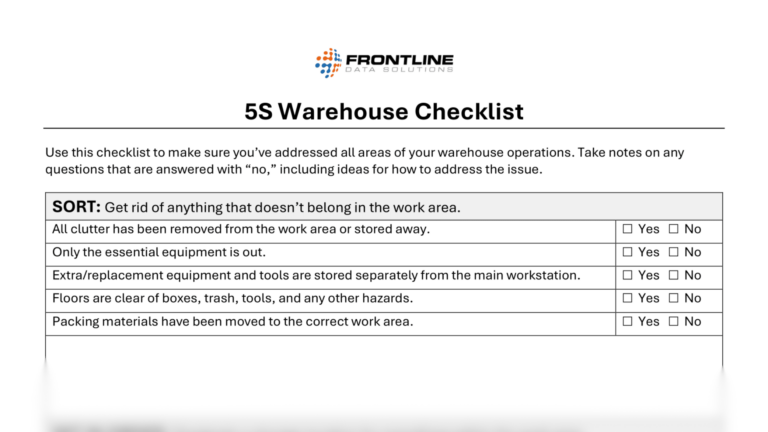How to organize warehouse inventory
Anyone who’s ever worked in a warehouse understands the rush that comes with finding a long-forgotten piece of inventory covered in an assortment of dust particles and stickers. When did it go missing? And more importantly—how did it go missing?
While there’s no agreed-upon standard for how to organize warehouse inventory, there are some leading best practices that you can adopt.
Thanks to modern technology, there are many different systems for organizing products so they’re easier to find and access. And you can mix and match these ideas to create an inventory management system that works best for your workers.
Digital versus manual inventory
There are two main ways to manage your inventory: digitally and manually. Manual methods involve using paper records and spreadsheets to keep track of your inventory. Digital methods use software programs to help you manage your inventory.
Both methods have their advantages and disadvantages—the primary one being cost. Smaller warehouses may not need a software system to keep an accurate inventory. Typically, however, as businesses expand, they need more help keeping track of what’s in stock.
You may consider upgrading from a manual to a digital inventory recordkeeping system once you expand to new locations or begin heavily diversifying the type of products you sell. The key is to make this switch before your current system becomes unmanageable.
Trying to adopt a new software solution when you’re already overwhelmed can be a nightmare for both your team and your software provider. The best approach is to choose a digital inventory system in the months leading up to an expansion. That way, whatever system you integrate will be fully functional and ready to quickly import new products and storage details.
Stock rotation
There are several methods of stock rotation that businesses use. Here’s a quick refresher of the most common options:
First in First Out (FIFO): Product leaves the warehouse in the order in which it first arrived.
Last in First Out (LIFO): Product leaves the warehouse in the order in which it last arrived.
First Expired First Out (FEFO): Product leaves the warehouse in the order of its expiration date.
The type of products you sell should dictate what kind of stock rotation you use. FIFO is best for products that have expiration dates but are relatively shelf stable. It’s also a popular method for trendy consumer goods that may go out of style by the next season.
Businesses who turnover inventory quickly often take the LIFO approach because it doesn’t affect the overall rotation—goods won’t be hanging around long anyways. This is also a common system for businesses that have a lot of variation in their cost of goods sold. By selling the latest inventory right away, the sales price better aligns with the inventory cost—making it easier to predict the cost of warehousing the product.
The last method, FEFO, works best for products that expire quickly. You don’t want to warehouse milk, for example, any longer than needed because it might expire before it reaches the customer. This is the most complex approach to inventory rotation but may be essential for maintaining profit margins.
Product line organization
The complexity of your product offering is another factor you want to consider when organizing your warehouse inventory. For example, if you sell products online, you might organize your inventory by product type (e.g., clothing) or by category (e.g., shoes). This will make it easier to find what you need when you need it.
Conversely, if you only sell one type of product, your system will be relatively simple. In that case, it might make sense to organize the inventory simply according to when it arrived. This will make stock rotation a breeze and reduce the likelihood of inventory collecting too much dust.
If you operate a large warehouse, you want to make sure that all employees are trained in proper inventory management. In some cases, maybe you have people who specifically stow and pick items from pallet locations or bins. In other cases, you might need all your new hires to understand how to organize inventory.
Either way, your training program should include the basics of stock rotation, safe storage techniques, and organization strategies. You want anyone within the warehouse to understand your inventory management system and to know how to maintain it.
Free checklist!
Use this 5s checklist to ensure that your warehouse is clean and organized on a regular basis.
Inventory storage equipment
Once you’ve decided how you’ll rotate and categorize your inventory, you’ll need to decide what equipment you’ll use to store it. Here are the three most common options:
Bins: Best for small, individually packaged items (clothing items, small toys, etc.)
Racks: Best for uniformly packaged items (pallets, boxed items, etc.)
Shelves: Best for large, individually packaged or uniquely shaped items (tires, furniture, etc.)
Most large warehouses use a combination of these systems to safely store their inventory. Regardless of which equipment you use, you want to make sure to always stow the heaviest items at the bottom to avoid damaging lighter and/or smaller items.
Additionally, you want to consider how often you’ll clean these storage locations. Dust is inevitable within a warehouse, but not enough facilities take advantage of the opportunity to clean when these storage locations are temporarily empty.
Auditing your inventory system
Anyone in operations management understands the importance of enforcing a system once it’s in place. If you train your workers how to organize warehouse inventory and how to keep it organized, you’re already a step ahead. This is a key component of ensuring that stock is rotated properly and protected from damage.
Many companies now use corrective action software to audit and course correct their warehouse management systems. This tool allows teams to upload inventory logs, document warehouse audits, create action items for improvement, and oversee those actions to completion.
Automating these practices makes it easier to focus on innovating your warehousing practices. With sufficient oversight, you’ll have a better chance of keeping the site clean, reducing the number of products that get misplaced or broken while in storage.
Going beyond product inventory
To reach your full organizational potential, it’s important to treat your tools, equipment, packing materials, papers, and any other warehouse essentials the same way you treat your products. A truly organized warehouse is one where every item, regardless of its relationship to the customer, has a place.
The best way to achieve this level of organization is to implement a 5S program at your site. By carefully considering how each area is organized, you can establish easy standards for keeping them that way.
This means that cleaning products and tools have their own storage location. Bathrooms and breakrooms are always stocked with essentials. Workers have access to refills of packaging materials and PPE. And everyone works together to keep these systems in place.
Having a tidy warehouse ultimately translates to a better experience for both your workers and customers. And those are benefits you can take to the bank, with lower variable costs on items that might have gotten lost or damaged in a disordered warehouse environment.




